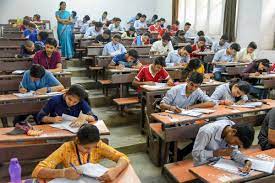In simple words, a competitive exam can be defined as a standardized form of assessment, which aims at bringing out the qualitative candidates among the group, for a specific opportunity. Through this approach, any organization or system focuses on individual assessment for passing a course or grade, and based on the scoring, selection is done.
As the name signifies, there exists a high level of competition among the applicants as thousands, or even millions of candidates may take the same exam to avail the limited opportunity. Hence, it becomes tough to secure a seat or a position.
To mention some of the key features, one may consider about the below given points:-
1. Purpose: The main purpose behind conducting competitive exams is to select the most qualified candidates among the numerous applicants
2. Standardized format: The format of the structure of the exam is predetermined and fixed, providing with a syllabus which ensures candidates’ well understanding of the format as everyone’s educational background is diverse. This hints at the fairness of the exam conducted.
3. High stake: Competitive exams hold a significant position nowadays as it brings out potentiality which ensures to influence one’s career choices.
4. Multiple selection rounds: Initially competitive exams held for securing jobs and it’s includes multiple selection rounds like preliminary, mains and personality test. Nowadays, this type of exam is conducted to select students for a particular course, and thus consists only of one round of selection.
5. Targeted skills and knowledge: The content is framed in such a way that it targets only at specific skills or knowledge for the availed opportunities.
6. Time bound: Competitive exams are typically time-bound, adding pressure and testing the candidate’s ability to work under pressure and manage time effectively.
7. Assessment: In most of competitive exams, the organizing authorities seek to adopt MCQs for the first round; subjective questions for the mains round which require more open-ended responses and assess analytical thinking, critical reasoning, and writing skills. In personality test, cognitive abilities like reasoning, problem-solving, and decision-making are assessed. Besides, skill tests are also conducted if the opportunity is for areas like coding or laboratory work.
8. Strategic planning: Due to the large number of applicants, competition can be fierce, requiring dedicated preparation and strategic planning.
Here are some common types of competitive exams:
1. Entrance exams: Entrance exams conducted to get admission into prestigious universities for various programmes, are nowadays considered very important for students in their career. For example, CUET (Common University Entrance Test).
2. Public service exams in state as well as central level: To get most desired jobs in public sector, UPSC plays a crucial role at central level to get jobs like IAS, IPS, IFS etc. Similarly all the states conduct their own exam to recruit public officials.
3. Professional licensing exams: These types of exams are conducted in professional courses like law, medicine, engineering etc.to let them practice their specific domains.
4. Scholarship exams: Considered as one of the demanded exams, scholarship exams are conducted to award financial aid to deserving candidates based on their performances.
HISTORY/ ORIGIN
Competitive exams have a long and intriguing history, stretching back to ancient civilizations and evolving through different cultures and eras. Arguably, the earliest documented system of competitive exams can be traced back to ancient China in the 2nd century BCE. The imperial examinations tested candidates on Confucian classics, literature, and calligraphy, serving as the primary route to government service. Around the same period, early forms of competitive exams existed in India for selecting scholars and priests. These often focused on Vedic knowledge and religious texts. While not widespread, competitive elements were present in ancient Greece and Rome for selecting scholars and officials. For example, public debates and orations played a role in identifying talented individuals.
During the Middle Ages, the rise of universities led to the development of examinations for obtaining degrees and qualifying for professions like medicine and law. With the growth of centralized governments and bureaucracies, competitive exams gained momentum in Europe and North America. The introduction of the civil service exam in Britain (1855) and the SAT in the US (1926) are notable examples. With the fast pace towards 20th- 21st century, globalization and the need for standardized assessments spurred the widespread adoption of competitive exams across the world. Entrance exams for higher education, professional licenses, and even public sector jobs became commonplace in many countries.
The history of competitive exams is, thus, a fascinating journey through different cultures and intellectual landscapes. While their role in selection and opportunity remains significant, ongoing debates and evolving assessment methods ensure that their future continues to be shaped by critical reflection and adaptation
COMPETITIVE EXAMS IN INDIA
India boasts a vast and diverse spectrum of competitive exams catering to various educational and professional aspirations. For higher education, nowadays, entrance examinations hold a pivotal role. At UG level, Joint Entrance Examination (JEE) Main & Advanced (engineering), National Eligibility Entrance Test (NEET) (medicine), Common Law Admission Test (CLAT) (law) etc. are noteworthy.
Similarly, at PG level, Graduate Aptitude Test in Engineering (GATE) (engineering & science), Common Management Admission Test (CMAT) (management), Graduate Pharmacy Aptitude Test (GPAT) (pharmacy), Master of Dental Surgery (MDS) entrance exams, and various university-specific postgraduate entrance exams are being conducted.
When it comes to government services, competitive exams are necessary. Union Public Service Commission (UPSC) Civil Services Examination (CSE). Considered as one of the toughest examinations worldwide, this grants access to top administrative positions in Indian government services like Indian Administrative Service (IAS), Indian Foreign Service (IFS), and Indian Police Service (IPS). Similar to that, State-Level Public Service Commission (PSC) Exams are conducted for the recruitment to various state government positions.
Another popular exam in India is SSC (Staff Selection Commission), which conducts various exams for recruitment to various levels of Central Government ministries and departments, including Combined Graduate Level (CGL), Combined Higher Secondary Level (CHSL), and Stenographer exams.
In banking sectors, exams like SBI PO, IBPS PO, and IBPS Clerk provide entry into different positions in public sector banks. Again, in defense forces, National Defence Academy (NDA) & Naval Academy (NA) Entrance Exam, Combined Defence Services (CDS) Examination, and Air Force Common Admission Test (AFCAT) offer pathways to officer positions in the Indian Army, Navy, and Air Force.
Apart from government services, competitive exams are also conducted for providing professional licenses. All India Council of Chartered Accountants (ICAI) conducts exams for aspiring Chartered Accountants, a highly sought-after professional qualification in finance and accounting. Besides, Institute of Company Secretaries of India (ICSI) conducts exams for aspiring Company Secretaries, who play a crucial role in corporate governance and legal compliance.
CUET
Usually known as CUET (Common University Entrance Test) which is conducted for UG and PG levels at various universities across India. Nowadays, it’s gaining broad recognition among the students to get a chance to enroll themselves in prestigious universities. It both has positive as well as negative aspects.
Positive aspects:
1. Reduced burden: It eliminates multiple entrance exams for various universities, reducing stress and workload for students, as well as reduction in cos
2. Standardized benchmark: Provides a single platform for comparing student performance across diverse academic backgrounds.
3. Level Playing Field: Offers meritocratic selection, potentially creating a fairer system for admissions compared to individual university exams.
4. Streamlined process: Simplifies the application process for students seeking admission to multiple universities.
5. Promotes interdisciplinary: Encourages broader learning by requiring students to prepare for multiple subjects, potentially fostering well-rounded graduates.
Negative aspects:
1. The single test format might overlook diverse learning styles and strengths of students from different educational backgrounds.
2. The high-stakes nature of the exam can create undue pressure and anxiety for students, impacting their performance.
3. Concerns exist regarding accessibility for students from underprivileged backgrounds who may lack resources or adequate preparation for the exam.
4. The introduction of a new exam system can lead to unforeseen technical glitches or implementation issues, causing disruption and uncertainty for students.
5. The test, being in CBT mode, might cause tensions among students as not every students are aware of using computer in a proper way.
6. The long process of checking and verifying documents right before the examination create troubles in the students. Apart from that, the digital authentication creates further tensions.
7. Some argue that this exam prioritizes rote memorization and conformity over creativity and critical thinking.
CONCLUSION
Rather than objective questions throughout the paper, half weightage should be given to subjective questions which would bring out creative potential and one’s language skills. It is seen that students who cleared CUET PG and enrolled themselves into Master Degree programs are lacking behind in good language skills which lead them to face various problems. Moreover, those who are on the top list during this examination are staying far behind to present themselves well in the university examinations which shows that they tried their luck and blindly tick at the provided options during the exam, as for every correct answer there’s 4 point and every incorrect answer, there’s negative marking of -1. Due to this, some students took the risk to select any option although they’re not sure about the correct answer.
By: Jimi Bora
Write and Win: Participate in Creative writing Contest & International Essay Contest and win fabulous prizes.
















